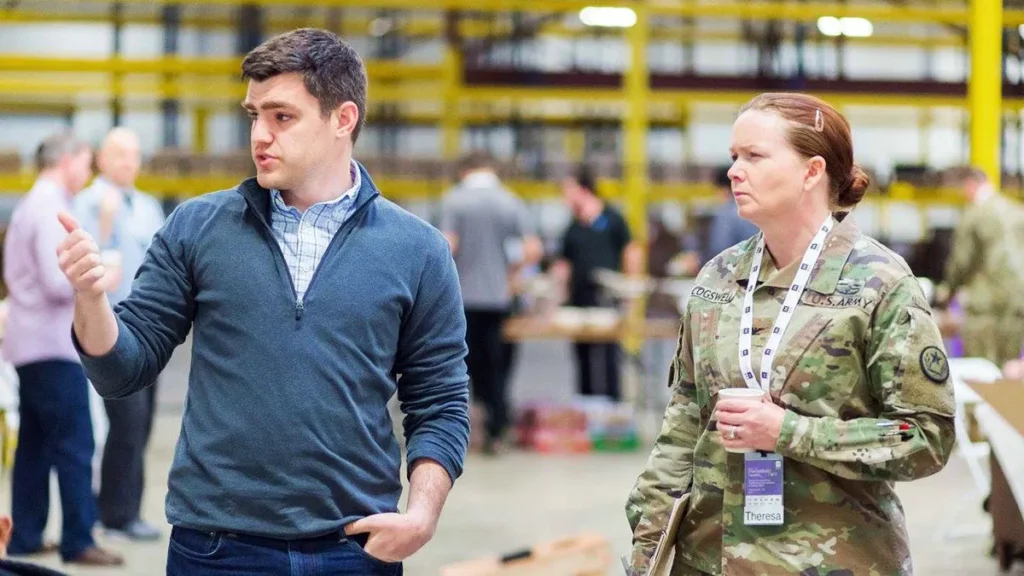Picture this: In a seemingly ordinary campus classroom, twenty future trailblazers are diving headfirst into the heart of innovation. Hailing from schools all over campus, they work side by side with the defense and intelligence communities to tackle real-deal national security problems.
What awaits them is nothing short of a hands-on, high-energy rollercoaster of an experience. They’ll be rubbing elbows with the best and brightest minds in the defense and intelligence realms, working at warp speed to crack codes, brainstorm solutions, and tackle challenges that’ll make their heads spin (in the best way possible).
Of course, we’re talking about the newest cohort for Innovation for Impact: Defense and Security. This course, led by Lieutenant Colonel David Brewer, Jr. in partnership with the National Security Innovation Network and Common Mission Project, pairs student teams with mentors to solve real defense and security issues facing our country.
This year’s cohort is diverse, including students enrolled in the College of Engineering, LSA, Ross School of Business, and Gerald R. Ford School of Public Policy. Together, these students make up five teams, all of which have the potential to make lasting change. Read on to learn more about each project team and get a sense of what students are working on.
Team 1: Spoof Proof
Working with the U.S. Army’s 1st Battalion, 26th Infantry Regiment, this team is tackling the intricate dance of counter-battery fire tactics. Imagine this – a sleek, deployable mechanism armed with false emitters to outsmart enemy radars. We’re talking compact, long-lasting, and remotely controlled tech that’s a game-changer. The ultimate goal? Make the enemy blink first, allowing Joint Forces to swoop in with a strategic upper hand. It’s innovation on the frontline, reducing risks and amplifying the power of U.S. Forces. Now that’s a mission worth cheering for!
Team 2: Mixed Signals
Next up, we’ve got the visionaries of Mixed Signals, joining forces with the U.S. Space Force’s 709th Support Squadron. Their mission? To revolutionize seismic tracking. Think faster tests, streamlined evaluations, and a digital upgrade that makes BASH scripts look like ancient scrolls. The result? A seismic game-changer that simplifies tracking and evaluation processes.
Team 3: Superblend
Now, let’s talk about Superblend – a collaboration between the U.S. Air Force and Army’s 7th Special Forces Group (Airborne). They’re taking soldier assessments to a whole new level. It’s not just about physical fitness; they’re diving deep into mental, psychological, and spiritual readiness. Together, these students will work toward a solution that allows soldiers to step into deployment with a holistic approach to readiness, potentially saving lives and easing military families’ worries.
Team 4: Plug and Drop Pro
Imagine working with the U.S. Air Force to redefine airdrop missions. This group aims to seamlessly integrate with Mission Planner, making precise calculations and ensuring accurate cargo delivery in GPS-degraded scenarios. This isn’t just about military missions; we’re talking humanitarian aid, search and rescue – a technological leap that benefits us all.
Team 5: Swarming Storm, Skies Secured
Last but certainly not least, the U.S. Air Force is counting on students’ help to tackle hostile drone invasions with swarming UAS technology. Picture a coordinated dance of drones, detecting and neutralizing threats. The desired result? Enhanced civilian and military safety.
As these twenty exceptional students embark on their journey within the Innovation for Impact: Defense and Security course, the stage is set for a truly groundbreaking academic adventure. With each team meticulously addressing distinct challenges, from counter-battery fire tactics to seismic tracking and soldier assessments, the potential for lasting change is palpable. Stay tuned as we follow these teams on their quest to revolutionize the future of national security and contribute to a safer world. The adventure has just begun, and the possibilities are endless!

